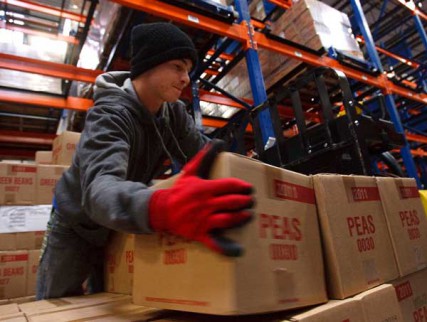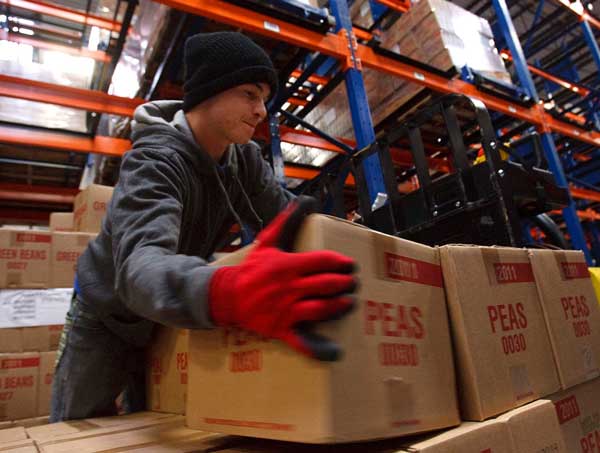SALT LAKE CITY (RNS) At the new Utah Bishops' Central Storehouse, pallets loaded with food wait to be ferried to locales near and far, their destinations handwritten in black marker on plastic wrap covers: Lindon, Ely, Mesa, San Diego, St. George.
Storehouse manager Richard Humpherys stops a golf cart next to one steel storage rack, slits open a cardboard box with a pocket knife and pulls out a can of peaches made with fruit grown at a Mormon church-owned orchard and processed at its cannery in Lindon, Utah. The can's label is stamped “The Church of Jesus Christ of Latter-day Saints” and “Welfare Services, Salt Lake City, Utah.”

Storehouse worker Matt Van loads boxes of peas for shipment Thursday, Jan. 26, 2012, to one of the other five distribution centers. The Church of Jesus Christ of Latter-day Saints has completed a new 570,000-square-foot Bishops' Central Storehouse in Salt Lake City on a nearly 36-acre site. The storehouse is central to the church’s welfare and humanitarian programs. The storehouse includes administrative offices, bulk/rack storage and refrigeration areas. The site will also support the church’s trucking fleet.
This, Humpherys said as he holds the can in his palm, is “the best food money can't buy.”
The new storehouse, which opened in January, is the centerpiece of the Mormon church's intricate network for taking care of its members and lending a hand to others in times of natural disasters, putting scriptural encouragements into action in the aftermath of hardship.
“As I walk through, I (don't) think, 'What a beautiful building' but how the Lord must truly love the poor to provide this building to take care of their needs,” Humpherys said during a tour of the facility, built with members' donations.
Since its inception, the LDS Church has viewed looking after its members' well-being as part of its core mission. During the Great Depression, when unemployment ran 30 percent among members, the church formalized its welfare system. It opened the first regional storehouse in 1937 in Salt Lake City and began to buy orchards, farms and cattle ranches to provide commodities to redistribute to those in need.
The church buys many items it keeps on hand today at the storehouse — from wheelchairs to sugar and rice. But the system works much the same way it did at its start: It begins with a call from a Mormon bishop seeking help either for his congregants or his community.
It has never been a “dole” system, Humpherys said, which “helps maintain the dignity” of the process. A recipient may be asked, for example, to help clean a church or fix a widow's fence in exchange for aid; a single mom might be asked to “stay home and take good care of her kids.”
Today, the central storehouse uses its own fleet of trucks to take food and supplies across the country to five regional storehouses, from Alberta to metro Atlanta. From there, the goods fan out to more than 200 local storehouses.
But the Salt Lake City storehouse is command central, especially in a natural disaster. It can dispatch food, supplies and volunteers anywhere in the U.S. within 12 hours to 18 hours of a disaster, though it often reacts even quicker. That success has triggered visits from the Federal Emergency Management Agency, Defense Department and other government agencies wanting to know how the Mormons do it.
The answer, he said, is the church's lay leaders who know their community's needs, its supply network and a massive number of volunteers ready for action.
“There are things they can't duplicate,” he said. “On the other hand, there are things we can't do, so we try to work in partnership with the government and other religious groups.”
Consider the earthquake that struck Haiti on Jan. 12, 2010. By the time LDS leaders in Salt Lake City wrapped up the initial call for help from Haitian bishops, six semis loaded with supplies were already making their way to Miami, where the goods were to be flown by military transport to the devastated country.
Or Hurricane Katrina in 2005. The storehouse dispatched semis packed with food and supplies while the storm battered the Gulf Coast. The trucks formed a semicircle that stretched from Texas to South Carolina, where they waited until the winds and rains abated enough for them to make their way into the worst-hit areas. In all, the LDS church sent 450 semitrailers of food and supplies and coordinated work of 4,000 volunteers a week.
Humpherys acted with similar speed when Hurricane Wilma socked Florida later that year. As the storm stalled over the Yucatan, Humpherys readied four big rigs and put them on the road, telling drivers he would let them know later where they were headed. Meanwhile, he delivered satellite phones to Mormon bishops and told them to call if they needed help.
Among the first to phone: a Miami-area bishop who was providing refuge to 200 people in a church building that lacked power, food and other supplies. Humpherys let him know a truck would be able to reach him in 30 minutes.
“He called back after they'd unloaded,” Humpherys recalled, “and said, 'You have no idea how much that meant to our people to see a Deseret Transportation truck there 30 minutes after the storm passed.'”
For disasters outside the U.S., the LDS Church typically sends cash rather than food and supplies, avoiding expensive shipping costs and helping to re-energize local economies while also ensuring people get what they need. That's “rice and beans in South America,” Humpherys said, “versus peaches and peanut butter.”
Humphreys likes to tell a story from Katrina, when an older couple from Utah, were sent to work at the bishops' storehouse in Slidell, La. The woman called Humpherys one day, upset. Another church group, she complained, was taking canned goods and plastering its own labels over those of the LDS church.
Humpherys asked her: “What's the real issue?”
People are hungry, she said. Right, he answered.
“It doesn't matter what it says on the outside,” he told her. “It's what's inside – and inside your heart.”
(Brooke Adams writes for The Salt Lake Tribune.)





